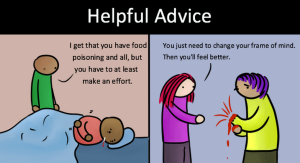
Person calculating finances while holding credit cards.
The cycle of systemic poverty and homelessness is nearly impossible for anyone to break out of. The combination of not having enough funds for everyday necessities under capitalism and a lack of a suitable shelter under which to sleep can be crushing to the human spirit.
Under structural transphobia, trans people are at increased risk for unemployment and homelessness, with trans women of color—who are three times as likely as the general population to be unemployed—bearing the brunt of this oppression.
When I began my own transition, of course, homelessness lingered as a fear in the back of my mind. I’d watched too many trans women be run out of their jobs under suspicious circumstances and subsequently struggle to find another job to believe I was entirely immune to the possibility.
Housing insecurity is a major issue for the trans community and already sparse shelter resources could potentially be a hostile environment for a trans woman, myself included.
As a trans woman, I have a natural fear of cis-operated spaces, as the potential for transphobia is ever present. For example, the Salvation Army has been accused several times of harassing or even banning trans women from their shelters. I wouldn’t even risk availing myself of their services.
Taking into account that a great many shelters and anti-poverty charities are affiliated with or operated by churches, I would be leery of seeking the same help as a homeless cis person.
And with trans people making up just 0.6% of the population, it’s especially difficult for organizations to provide appropriate local trans-specific resources and a welcoming support system in order to help folks breakout of the systemic poverty cycle.
In order to figure out the best ways to help trans people breakout of systemic homelessness, I turned to the trans-run organization Hypatia Software Org.
According to President/CEO, Lisa-Marie Maginnis, Hypatia’s mission is “to end homelessness and the disenfranchisement of people who experience transmisogyny through peer mentorship, emergency cash relief, and community building.”
Here are 4 ways they say we can help get trans people out of poverty now:
1. Let trans people who have been homeless take the lead
The centerpiece of Hypatia’s approach is their peer mentorship program which recruits trans people who have struggled with extreme poverty to mentor trainees as they work through a year-long course in software development.
Says Maginnis, “The idea is that if you see a peer who has gone through a similar experience as you but is not currently experiencing homelessness, you’ll feel like it’s now attainable and it’s not an impossible proposition to change your life experience.”
The program is a unique boon for a population that has always struggled with extreme poverty and pays homage to the cultural idea of paying it forward that sometimes runs strongly through the trans community at large.
Our community’s prospects have been raised by previous generations, and it’s up to each successive generation to leave the world a better and safer place for those that come out after us.
Maginnis continues, “Hypatia is founded on the very idea that together we can raise each other up out of homelessness and into the IT world.”
2. Share decision-making responsibilities among the whole group
According to Maginnis, every major decision that HSO makes is voted on by both the students and volunteers, all of whom are trans themselves.
“It’s a formal consensus process where any member if they have an idea, we wait seven days and debate it, and if we all agree, the proposal becomes part of Hypatia’s mission… This enables the very people your organization is supposed to serve to have power and run their own community as opposed to being told what to do.”
This dynamic has manifested itself in several positive ways.
Hypatia itself began as a loosely organized effort with a mission to help homeless experiencers of transmisogyny break out of the poverty cycle. Most people within the trans community define transmisogyny as the unique intersection between misogyny, homophobia, and transphobia exclusively experienced by trans women, and so, at first, Hypatia only assisted trans women.
However, a vote within the membership at large ended up changing the internal definition of transmisogyny to include anyone who identifies as experiencing transmisogyny, including those who may not be trans women.
As a result, Hypatia is now open to any homeless trans person, not just trans women. It’s just one example of why letting those who the program is meant to help make the major decisions can turn out with positive results.
3. Help trans folks find employment in trans-friendly industries
Trans people are marginalized in a number of unique ways within employment settings, and employment law has not yet fully caught up with the fairly recent growth of out trans people across the US.
As a result, employers willing to allow trans people to thrive are vital in helping them build a stable enough employment history to break free of the bonds of poverty.
While there are very few industries that are specifically supportive of trans employees, Hypatia believes that the tech history has proven to be particularly welcoming.
“We push for technology jobs because we find the tech industry, while still problematic, to be one of the more friendly industries for trans people. There seem to be more trans people successfully employed in the IT world than there are other industries, visibility-wise.” Said Maginnis.
By focusing on the tech sector, Hypatia can offer their training program nationwide online in an accessible setting.
When students graduate from Hypatia’s year-long training program, they’ll be certified Python developers, a valuable qualification that is very marketable to potential IT employers.
Historically, the tech industry, with heavy ties to the San Francisco Bay Area, has a long history of support for the gay and lesbian community, and that history has translated into a relatively supportive environment for trans tech workers.
4. Support initiatives that provide sudden cash infusions for trans folks
When you’re homeless, every day is a financial crisis and most of Hypatia’s fundraising efforts go towards assisting students with enough cash to be able to keep attending classes. Enter Hypatia’s emergency cash relief fund.
“It’s used for food, transportation and access to medicine for students who would drop out of the program otherwise,” says Maginnis of the thought process behind the fund. “By stabilizing them, we allow them to complete the program, by completing the program, they’re left with their first open source project for their portfolio.”
While there are social media hashtags like #transcrowdfund (created by black transfemme J Skyler) and organizations like the Jim Collins Foundation which helps fund gender affirming surgeries for trans people in need, that can help with these emergency funds, Hypatia takes it one step further and becomes a one-stop shop for both valuable employment training and dispersal of direct assistance cash.
Often students in the HSO program have no access to a laptop, and so must raise enough funds to grab a bus to the library to complete their one hour/week program. Because of this, Hypatia is rolling out extensive fundraising efforts for 2018.
***
The fact is: there’s no easy answer to systemic poverty within the trans community. It will take several generations to deconstruct the social attitudes that make employers less likely to hire and retain trans employees, so in the meantime, it’s survival mode for us.
Key to that survival are organizations, such as Hypatia Software, that continue doing the real work.
[do_widget id=’text-101′]
Katelyn Burns is an Everyday Feminism Reporting Fellow. Katelyn is a freelance journalist and trans woman. She has previous bylines for The Washington Post, The Establishment, and VICE, among others. She lives in Maine with her two young children. Read her other articles here.
Search our 3000+ articles!
Read our articles about:
Our online racial justice training
Used by hundreds of universities, non-profits, and businesses.
Click to learn more




















